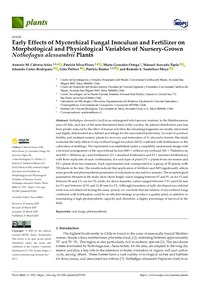Early effects of mycorrhizal fungal inoculum and fertilizer on morphological and physiological variables of nursery-grown Nothofagus alessandrii plants
Autor
Cabrera-Ariza, Antonio
Silva-Flores, Patricia
González-Ortega, Marta
Acevedo-Tapia, Manuel
Cartes-Rodríguez, Eduardo
Palfner, Götz
Ramos, Patricio
Santelices-Moya, Rómulo
Fecha
2023Resumen
Nothofagus alessandrii (ruil) is an endangered relict species, endemic to the Mediterranean area of Chile, and one of the most threatened trees in the country. Its natural distribution area has been greatly reduced by the effect of human activities; the remaining fragments are mostly intervened and highly deteriorated as a habitat and refuge for the associated biodiversity. In order to produce healthy and resistant nursery plants for recovery and restoration of N. alessandrii forests, this study evaluates the early effects of mycorrhizal fungal inoculum (MFI) combined with fertilization on the cultivation of seedlings. The experiment was established under a completely randomized design with a factorial arrangement of the mycorrhizal factors (M0 = without mycorrhizal, M1 = Thelephora sp. and M2 = Hebeloma sp.) and fertilization (F1 = standard fertilization and F2 = intensive fertilization), with three replicates of each combination, for each type of plant (P1 = plants from one season and P2 = plants from two seasons). Each experimental unit corresponded to a group of 20 plants, with 720 plants in the test. The results indicate that application of fertilizer and MFI significantly affects some growth and photosynthesis parameters of ruil plants in one and two seasons. The morphological parameters obtained in the study show shoot height values ranging between 67 and 91 cm for P1 and between 96 and 111 cm for P2; while, for shoot diameter, values ranged between 7.91 and 8.24 mm for P1 and between 10.91 and 11.49 mm for P2. Although formation of fully developed mycorrhizal roots was not observed during the assay period, we conclude that inoculation of mycorrhizal fungi combined with fertilization could be an efficient strategy to produce a quality plant, in addition to maintaining a high photosynthetic capacity and, therefore, a higher percentage of survival in the field.
Fuente
Plants, 12(7), 1521Link de Acceso
Click aquí para ver el documentoIdentificador DOI
doi.org/10.3390/plants12071521Colecciones
La publicación tiene asociados los siguientes ficheros de licencia:


